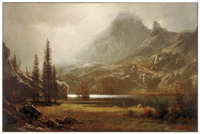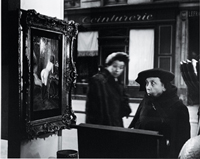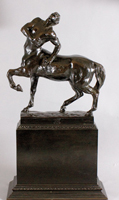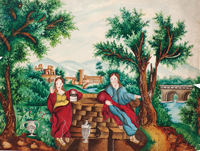Want to look at art? Take a course in geology, or psychology, or French conversation.
[Art] Hundreds of students come to the Mead Art Museum each semester as part of organized class visits. And they’re not all taking art or the history of art. In fact, the museum is routinely host to courses from throughout the college’s catalog. Students in these courses gather with their professors in a gallery or in the study room to examine works of art from the collection.
The Mead’s interim director, Pamela Russell, has organized class visits for the past five years as head of education. The effort to connect the Mead’s collection with courses began in 2007 through the efforts of former director Elizabeth Barker, now head of the Boston Athenaeum. Here are some of the courses that visited the Mead in recent years, with examples of objects they viewed.


BIG BOOKS
Object: Of Whales in Paint, in Teeth, &c
1 The 1990 Frank Stella sculpture is inspired by one of the biggest books of all, Moby-Dick, which was on the reading list of this first-year seminar. The acrylic-on-aluminum sculpture is more than 83 inches high.

STEREOTYPES AND PREJUDICE
Object: The Young Men
2 How do stereotypes and prejudices develop, why are they maintained, and how can they be reduced? Psychology students studied photos that depict instances of segregation and, in this 1992 photo by Tina Barney, privileged white men who display a sense of unease.

SEMINAR IN THE ANTHROPOLOGY OF MUSIC: LISTENING, HEARING, AUDITION
Object: Raga: Girl listening to musicians
3 This course examined listening as a culturally specific practice and as a kind of performance in its own right. Students viewed images that illustrate modes of listening to music. One was this 19th-century watercolor-on-paper from India.

GEOLOGY OF THE AMERICAN WEST
Object: By a Mountain Lake (Lake in the Grand Tetons)
4 Geology students studied the origins of the natural landscapes of western North America, giving special attention to national parks. Among the paintings they viewed was this 19th-century oil-on-canvas by Albert Bierstadt.

FRENCH CONVERSATION
Object: La Dame Indignée
5 To gain confidence in idiomatic French, students discussed French social institutions and culture. As part of this work, they studied various French photographs, including Robert Doisneau’s 1948 image of a woman showing surprise and shock.

MIND AND BRAIN
Object: Wounded Centaur
6 Students in this first-year seminar explored the human-animal connection through the representation of composite mythological creatures. They studied an 1890 bronze sculpture by German artist Franz von Stuck.

THE SECRET JESUS
Object: Christ and the Samaritan Woman
7 Religion students examined stories about Jesus that were well-known in antiquity but are less familiar today. They looked at images of Jesus in art, including this undated watercolor by American artist Hulda H. Conover Dayton (1828–1915).

INTRODUCTION TO THE PEOPLES AND CULTURE OF EURASIA
Object: Russian Marriage (Mariage russe)
8 A selection of Russian works of art provided a new context for students learning about the diversity of historical experiences of ethnic and national groups of Eurasia. This 1928 watercolor is by Konstantin Alekseevich Korovin.
1: 1994.8, gift of Steven M. Jacobson ’53 2: 1995.8, museum purchase with Allan P. Albert ’67 Photograph Fund 3: 1967.77.a, gift of Alban G. Widgery 4: 2002.129, given in memory of Nathalie Hawthorne Olena by her husband, Arnold T. Olena, and their children, Laura, Douglas, Kenneth, Randy and Marnie 5: 1979.109.a.1, gift of Kenneth Futter 6: 1973.5, museum purchase 7: 1950.33, gift of Miss Katherine C. Cowles 8: 2001.113, gift of Thomas P. Whitney ’37